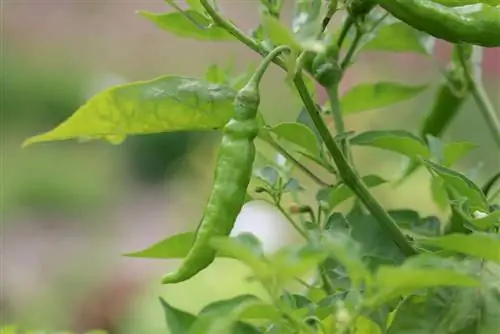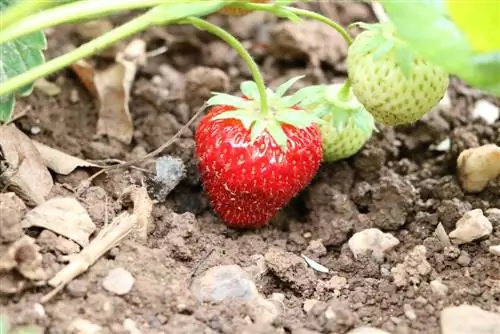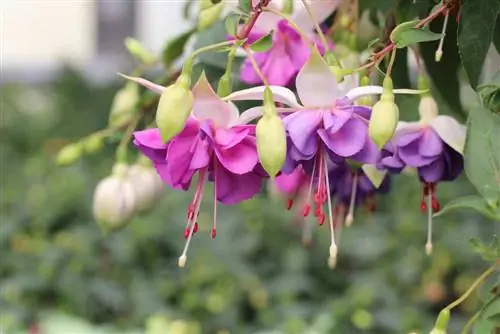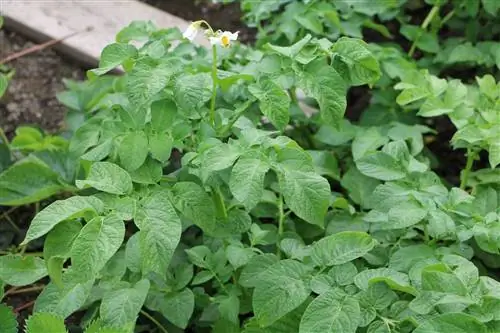- Author admin [email protected].
- Public 2023-12-17 03:39.
- Last modified 2025-01-24 12:45.
Potatoes are a must in hardly any vegetable patch. They are usually planted in spring. The exact time plays an important role in whether, when and how much is to be harvested. We have summarized the most important planting dates.
Pre-germination
Pre-germinating potatoes is the best way to start growing before the official start of the planting season. This brings with it some advantages:
- first harvest ripens earlier and higher annual yields possible
- better, faster growth
- accordingly early new space in the bed for further cultivation
- Pre-germination reduces the risk of diseases and pest infestations such as late blight and Colorado potato beetles
- first tubers to be harvested from mid/end of May
Best time
The best time for pre-germination is planting the tubers from mid-February - provided the temperatures are at least between seven and ten degrees Celsius and they are early varieties. Often the late winter weather does not yet produce these temperatures. A bright location in the basement or a greenhouse is ideal for pre-germination.

Mid-late varieties are planted for pre-germination between late March and early April. Late varieties must be pre-germinated by a maximum of August/September.
The planting time should be no more than four weeks before the usual planting date. If they lie for too long to pre-germinate, their growth power continually weakens, root formation decreases and growth becomes increasingly difficult.
Note:
If you garden according to the lunar calendar, you will find the best time to plant potatoes is in the first third of the year. Then the earth's forces should retreat, which can have a positive effect on underground plant growth. There is no scientific evidence of this, but numerous home growers with lunar calendar experience swear by it.
Plants without pre-germination
Planting the tubers directly into the vegetable patch requires the least amount of effort. Here too, the variety or the usual cultivation time frame determines from and until when they should be planted.
Early potato varieties can usually be put into the garden bed from the end of March. For medium-late potato varieties, the ideal period is between the end of April and the beginning of June. The “last” varieties of the planting calendar can still be planted well into October at at least seven degrees Celsius. If they are buried deep enough in the earth and the earth's surface is thickly covered with a cold-insulating layer, they usually survive the winter well. They then sprout from the earth in early spring of the following year.
Sowing date
A less common method of cultivation is sowing potatoes. If you still want to sow them, you have to wait on average between 60 and 70 days from the day of sowing until the harvest is ready.
Early varieties
Early varieties are ready for sowing from March onwards, but if the temperatures fall below seven degrees Celsius or even into the frost range, some seeds will break. When sowing so early, it is therefore essential to use protection against the cold or to do so in a greenhouse. For example, the following can serve as protection against the cold:
- transparent, translucent film
- Cold frame with appropriate cover
- Plant fleece
- thick layer of straw or mulch
- plus sunny, wind-protected location
The most popular early potato varieties include:
- Assets
- Bellaprima
- Christa
- Gala
- Leila
- Marabel
- Osira
- Rosara
Medium-late potato varieties

The ideal sowing date for medium-late varieties is mid-May with the Ice Saints. They are ready to harvest by August at the latest, such as the following varieties:
- Berolina
- Bintje
- Blue Swede
- Cilena
- Hansa
- Nicola
- Quarta
- Saskia
Late potato varieties
For the late varieties, the seeds are laid from the end of May to the beginning of June at the latest. This is also almost the last time for sowing and harvesting in September. The best-known late varieties include:
- Agria
- Albata
- Cascada
- Cilena
- Linda
- Vitolette
- Wotan
Tip:
No matter whether pre-germination, direct planting or sowing is desired, the potato bed should always be prepared for this. The best time for this is in autumn. Then the bed is dug up vigorously and generously enriched with compost.
Year-round potato cultivation
The usual potato season can increase in length through pre-germination and ensure higher harvest yields, but it ends in autumn at the latest. But it doesn't have to be that way. If you have a warm house or at least a temperature-controlled greenhouse, you can grow and harvest potatoes all year round. While the cold in the garden heralds winter rest, significantly higher temperatures in the greenhouse allow growth to continue. Here potato growers are independent of outside temperatures and other external weather influences.






